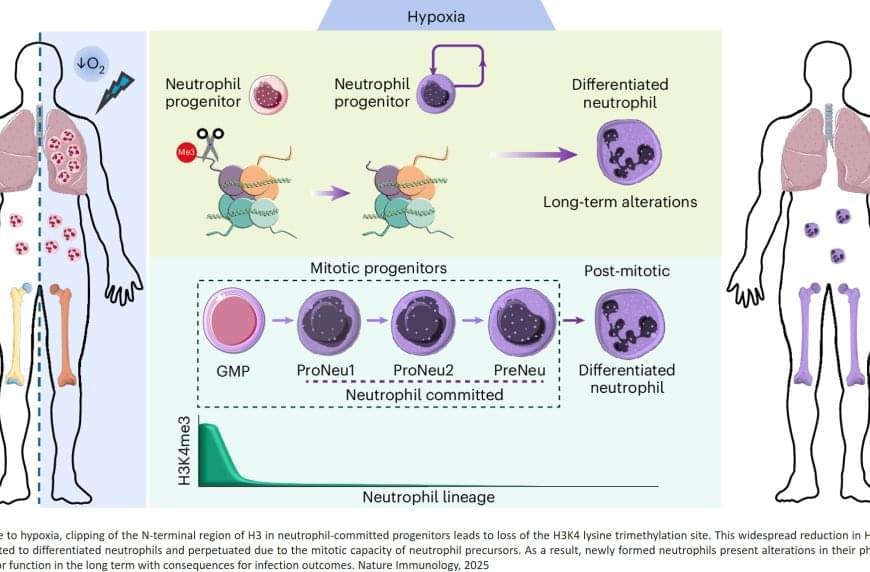A team of researchers used a massive dance video dataset and advanced AI models to map how the human brain interprets dance, revealing striking differences between experts and nonexperts.



Patterns of smartphone use and their impact on mental health are being extensively studied due to the growing dependence of the device in people’s lives.
A recent study tracked late-night smartphone usage in 79 adults with recent suicidal thoughts for 28 days. People using phones late between 11 p.m. and 1 a.m. showed a higher risk of suicidal thoughts the next day, whereas those who actively used the keyboard beyond midnight hours showed a lower risk.
The findings are published in JAMA Network Open.

Low oxygen levels in the blood can alter the genetic makeup of key immune cells, weakening the body’s ability to fight infection, new research shows.
Scientists found that oxygen deprivation – known as hypoxia – changes the genetic material of immune cells called neutrophils, reducing their capacity to destroy harmful microbes.
The team discovered that low oxygen appears to leave a lasting mark on the bone marrow cells that produce neutrophils, meaning the impact can persist after oxygen levels return to normal.

Mining the future – why technological development needs sustainable mines


Cai Borui and Zhao Yao from Deakin University (Australia) presented a concept that they believe will bridge the gap between modern chatbots and general-purpose AI. Their proposed “Intelligence Foundation Model” (IFM) shifts the focus of AI training from merely learning surface-level data patterns to mastering the universal mechanisms of intelligence itself. By utilizing a biologically inspired “State Neural Network” architecture and a “Neuron Output Prediction” learning objective, the framework is designed to mimic the collective dynamics of biological brains and internalize how information is processed over time. This approach aims to overcome the reasoning limitations of current Large Language Models, offering a scalable path toward true Artificial General Intelligence (AGI) and theoretically laying the groundwork for the future convergence of biological and digital minds.
The Intelligence Foundation Model represents a bold new proposal in the quest to build machines that can truly think. We currently live in an era dominated by Large Language Models like ChatGPT and Gemini. These systems are incredibly impressive feats of engineering that can write poetry, solve coding errors, and summarize history. However, despite their fluency, they often lack the fundamental spark of what we consider true intelligence.
They are brilliant mimics that predict statistical patterns in text but do not actually understand the world or learn from it in real-time. A new research paper suggests that to get to the next level, we need to stop modeling language and start modeling the brain itself.
Borui Cai and Yao Zhao have introduced a concept they believe will bridge the gap between today’s chatbots and Artificial General Intelligence. Published in a preprint on arXiv, their research argues that existing foundation models suffer from severe limitations because they specialize in specific domains like vision or text. While a chatbot can tell you what a bicycle is, it does not understand the physics of riding one in the way a human does.
Most strikingly, the paper claims four genuinely new mathematical results, carefully verified by the human mathematicians involved. In a discipline where truth is eternal and progress is measured in decades, an AI contributed novel insights that helped settle previously unsolved problems. The authors stress these contributions are “modest in scope but profound in implication”—not because they’re minor, but because they represent a proof of concept. If GPT-5 can do this now, what comes next?
The paper carries an undercurrent of urgency: many scientists still don’t realize what’s possible. The authors are essentially saying, “Look, this is already working for us—don’t get left behind.” Yet they avoid boosterism, emphasizing the technology’s current limitations as clearly as its strengths.
What we’re learning from collaborations with scientists.

Adeno-associated virus (AAV) vectors are the preferred gene delivery tool in gene therapy owing to their safety, long-term gene expression, broad tissue tropism, and low immunogenicity. Affinity ligands that can bind multiple AAV serotypes endure harsh clean-in-place (CIP) conditions and are critical for industrial-scale purification. However, current ligands lack broad serotype recognition and adequate alkaline stability, which limits their reusability in large-scale manufacturing. In this study, we employed a competitive biopanning strategy to isolate a single-domain antibody (VHH) that simultaneously binds AAV2, AAV8, and AAV9. The VHH retained structural integrity and binding activity after exposure to 0.1 M NaOH, demonstrating robust alkaline stability.

Adipokines provide an outstanding role in the comprehensive etiology of obesity and may link adipose tissue dysfunction to further metabolic and cardiovascular complications. Although several adipokines have been identified in terms of their physiological roles, many regulatory circuits remain unclear and translation from experimental studies to clinical applications has yet to occur. Nevertheless, due to their complex metabolic properties, adipokines offer immense potential for their use both as obesity-associated biomarkers and as relevant treatment strategies for overweight, obesity and metabolic comorbidities. To provide an overview of the current clinical use of adipokines, this review summarizes clinical studies investigating the potential of various adipokines with respect to diagnostic and therapeutic treatment strategies for obesity and linked metabolic disorders.